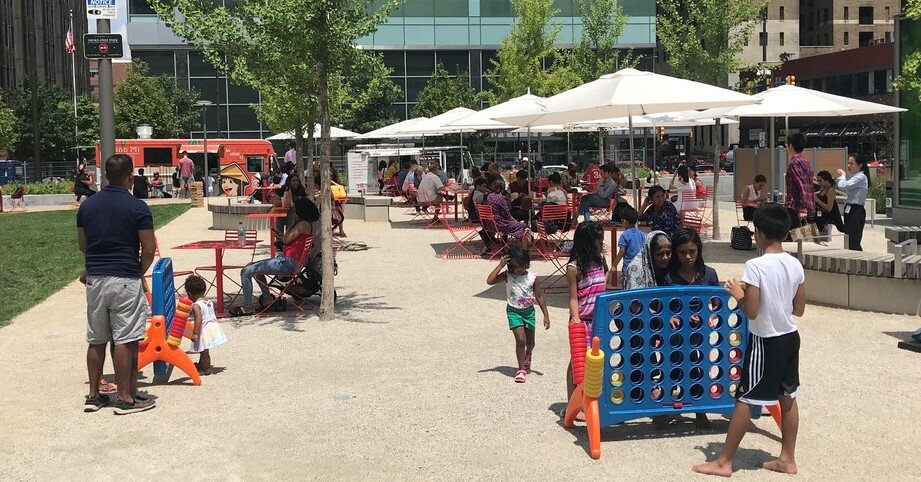Last week I wrote about how retail districts can be planned more thoughtfully, with community experiences at their core. This week I want to continue to tease out how the idea of community can be strengthened in planning and design, with the result of more diverse and integrated social environments.
If you look at how traditional public sector and institutional planning is usually done, we consult with our stakeholders and “the community,” and then plan a physical project that we hope reflects at least some of the ideas that rose to the top in this process. We use their ideas to make physical decisions, not social ones. And here we miss something big.
To me, the true value of working with the community is to determine what kinds of experiences and interactions they want with each other and the larger community. Therefore, the way we use community input should help create social settings, and the social interaction itself.
Typical Project Planning Process
So, let’s say that a university is planning a campus expansion, and reaches out to students, faculty, and staff for their input. Honestly, the university already knows 80% of what the expansion will consist of – they know the gym needs modernizing, the performing arts needs a new home, and that the science program will double in size over ten years, and so on. Meetings are held with the campus community, mainly to understand their preferences for physical environments – would they prefer rock-climbing or spin classes, should the campus be more urban or natural…that kind of thing. Discussions with faculty will put flesh on the plan – exactly what kinds of laboratories are needed? What size black-box theater will we have…? And in this process, a plan for facilities and open spaces will come into focus to lead development for years to come.
The process is pretty similar for all kinds of projects – innovation districts, master-planned communities, and comprehensive plans…they all have different takes on this process but boil community input down to a plan for physical environments.
Social Infrastructure is the Invisible Layer of Project Planning
But what about social environments? This aspect is barely sketched out in our plans. And when the plan starts to get implemented, guess what? No architect, no engineer, nobody is tasked with creating the social environments that are most central to the idea of “community.”
There’s a whole layer of social infrastructure that is invisible to most professionals in planning, design, and development; and every time we pass it over, we miss an opportunity to enrich our lives at the individual and community levels. For most of us, our social life is what animates us, inspires us, and motivates us to explore.
And think about the fact that so many ambitious projects rest on the assumption that if we build them they will come…and interact. The notion of adjacency is what cities were built on. Today we use this assumption to build our universities, urban districts, innovation districts, and town centers, the list is long. But we still lack the discipline to execute environments that fully realize the promise of social interaction.
Placemaking at Harvard University to Spark Innovation
Years ago, I got to work with Harvard University on their master plan for a new campus in the Boston neighborhood of Allston, which would double the size of Harvard by expanding across the Charles River. As a member of the Project for Public Spaces staff at the time, our task was to help integrate the incoming academic community with the existing Allston community so that there was a sense that they would integrate, and a better whole was created (and, frankly, so community resentment was minimized). Furthermore, Harvard knew that such a dramatic expansion of the campus could easily lead to a sterile collection of facilities and buildings that might not add up to a sense of place. No matter how cutting-edge the architecture, this new campus could easily lack the places that bring life, experiences, and meaning. They also wanted to make sure that there would be places that encouraged cross-fertilization – those chance interactions where people from different disciplines come together and talk about ideas, sparking innovation.
Our approach was very logical, and yet it’s level of programming that rarely happens: we basically took our long list of program ideas from meetings we held with Allston residents, and our ideas from workshops with students and faculty, and we threaded them together to imagine places where all those audiences would have a good reason to be there. This covered a wide range of place types, some on Harvard property and others along public streets, but all of them served a wide, and specific, spectrum of audiences.
There was a lot more work that we did from there, to plan for a continuum of campus experiences, indoors and outdoors. But this simple idea of being intentional with the program to integrate audiences was what I took away to apply to all kinds of projects.
Building Civic and Social Infrastructure with Placemaking
To this day, I use placemaking to create places that are diverse and integrated, that spark interaction and exchange, and that build our civic and social infrastructure. I still have a lot to learn about creating places that are more inclusive, and I welcome opportunities to work with others who can join their expertise to mine. Fred Kent always says, “When you design for people and places you get more people and places.” I would add that you actually can plan and design for more diverse places where people come together. Let’s start now!
Placemaking and development blog RSS

